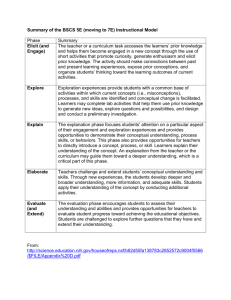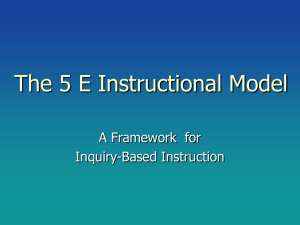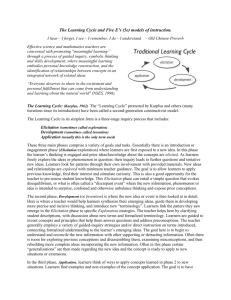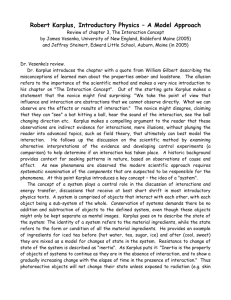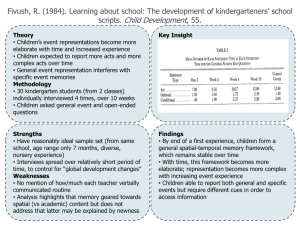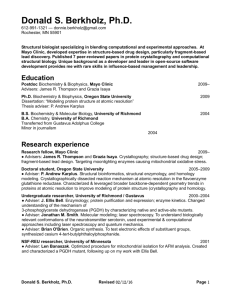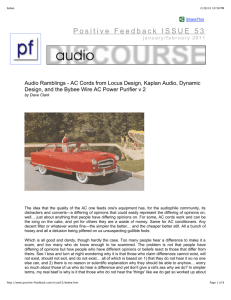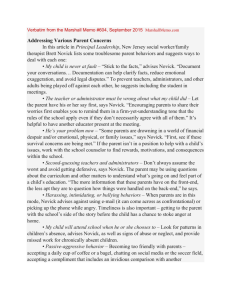“Learning Cycle”.
advertisement
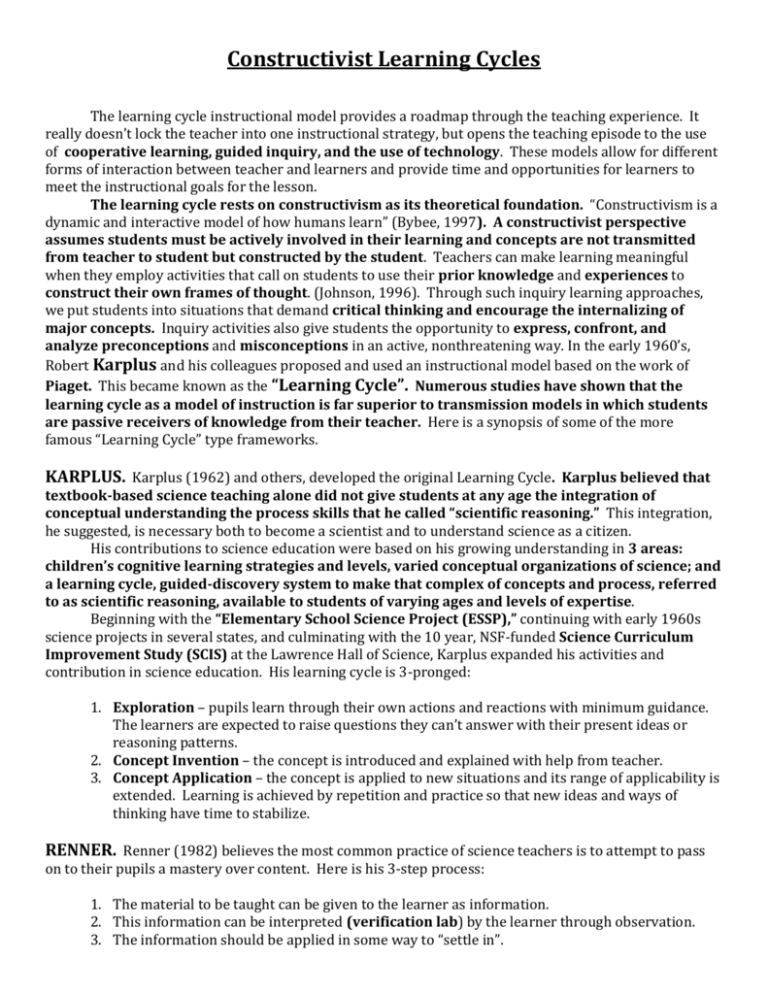
Constructivist Learning Cycles The learning cycle instructional model provides a roadmap through the teaching experience. It really doesn’t lock the teacher into one instructional strategy, but opens the teaching episode to the use of cooperative learning, guided inquiry, and the use of technology. These models allow for different forms of interaction between teacher and learners and provide time and opportunities for learners to meet the instructional goals for the lesson. The learning cycle rests on constructivism as its theoretical foundation. “Constructivism is a dynamic and interactive model of how humans learn” (Bybee, 1997). A constructivist perspective assumes students must be actively involved in their learning and concepts are not transmitted from teacher to student but constructed by the student. Teachers can make learning meaningful when they employ activities that call on students to use their prior knowledge and experiences to construct their own frames of thought. (Johnson, 1996). Through such inquiry learning approaches, we put students into situations that demand critical thinking and encourage the internalizing of major concepts. Inquiry activities also give students the opportunity to express, confront, and analyze preconceptions and misconceptions in an active, nonthreatening way. In the early 1960’s, Robert Karplus and his colleagues proposed and used an instructional model based on the work of Piaget. This became known as the “Learning Cycle”. Numerous studies have shown that the learning cycle as a model of instruction is far superior to transmission models in which students are passive receivers of knowledge from their teacher. Here is a synopsis of some of the more famous “Learning Cycle” type frameworks. KARPLUS. Karplus (1962) and others, developed the original Learning Cycle. Karplus believed that textbook-based science teaching alone did not give students at any age the integration of conceptual understanding the process skills that he called “scientific reasoning.” This integration, he suggested, is necessary both to become a scientist and to understand science as a citizen. His contributions to science education were based on his growing understanding in 3 areas: children’s cognitive learning strategies and levels, varied conceptual organizations of science; and a learning cycle, guided-discovery system to make that complex of concepts and process, referred to as scientific reasoning, available to students of varying ages and levels of expertise. Beginning with the “Elementary School Science Project (ESSP),” continuing with early 1960s science projects in several states, and culminating with the 10 year, NSF-funded Science Curriculum Improvement Study (SCIS) at the Lawrence Hall of Science, Karplus expanded his activities and contribution in science education. His learning cycle is 3-pronged: 1. Exploration – pupils learn through their own actions and reactions with minimum guidance. The learners are expected to raise questions they can’t answer with their present ideas or reasoning patterns. 2. Concept Invention – the concept is introduced and explained with help from teacher. 3. Concept Application – the concept is applied to new situations and its range of applicability is extended. Learning is achieved by repetition and practice so that new ideas and ways of thinking have time to stabilize. RENNER. Renner (1982) believes the most common practice of science teachers is to attempt to pass on to their pupils a mastery over content. Here is his 3-step process: 1. The material to be taught can be given to the learner as information. 2. This information can be interpreted (verification lab) by the learner through observation. 3. The information should be applied in some way to “settle in”. NUSSBAUM and NOVICK. Nussbaum and Novick (1981) try and explain what happens as learners change their conceptions during instruction. Their strategy is based on the principle that “science concept learning involves cognitive accommodations to an initially-held alternative framework. Ascertain student’s conceptions and modify these toward the current scientific view. Their cycle also is three-pronged: 1. Expose misconceptions (antecedent knowledge) dialog with others about beliefs 2. Teachers provide additional activities to promote the “cognitive dissonance”. 3. Accommodations develop from students searching for a solution to their conflicting ideas. BARNES. Barnes (1976) contends that learners need to take a prominent part in the formulation of their own knowledge. To help facilitate this he recommends that students should work primarily in small groups. His sequence has 4 parts: 1. A focusing stage where the teacher and students prepares the ground by presenting preliminary knowledge. 2. Exploratory stage involves discussion and activities. 3. Reorganizing stage refocuses attention and tells groups how they will be reporting back. 4. Public stage where learners present their findings to one another. OSBOURNE and WITTROCK (1983) They call this the Generative Learning Model (GLM). It had 4 parts: 1. Before formal instruction teachers assesses antecedent knowledge. 2. Provides experiences that help motivate student to explore their level of conceptual understanding. 3. Help students to compare and contrast ideas and to support with evidence their viewpoint. 4. Apply newly refined conceptual concepts in familial contexts. HEWSON-HEWSON MODEL – (1988) 1. 2. 3. 4. Diagnose students antecedent knowledge Provide opportunity for students to clarify their thoughts Contrast student views and desired views through teacher or class discussion Immediately provide opportunity for students to use the desired view to explain a phenomenon. 5. Provide immediate opportunity for students to apply their newly acquired understanding in novel situations. LAWSON-ABRAHAM MODEL – (1988) 1. Exploration – use lab activity to expose students to the concept. 2. Term or Concept Introduction – derive concept from data, classroom discussion. 3. Expansion – explore the usefulness and application of the developing concept. Lawson recognized that teachers can give students new terminology but the student must actively invent or generate the concept. BYBEE and 5E Learning Cycle (1992) - This cycle takes the Karplus Cycle and adds to it. The 3 original parts of the Karplus Cycle (Exploration, Invention, and Application) correspond to the middle 3 segments of Bybee’s Cycle. 1. 2. 3. 4. 5. Engage – Focus attention and pre-assess antecedent knowledge. Explore – Students actively share a common lab experience as they collect data. Explain – Use the data to solve problem, formalize vocabulary, and introduce concepts. Elaborate – Transfer and apply new concepts and information. Evaluate – Assess the other 4 areas This is not a linear sequence!!! Evaluation occurs in all four parts of the learning cycle. EISENKRAFT and the 7E Learning Cycle (2003) – This learning cycle uses Bybee’s and adds 2 more E’s to it. 1. 2. 3. 4. 5. 6. 7. Engage – See Above Elicit – Garner antecedent knowledge Explore – See Above Explain – See Above Elaborate – See Above Extend – Transfer knowledge and skills to new domains Elaborate – See Above The engage element is expanded into elicit and engage. The elicit really focuses on prior knowledge the students bring to class. The elaborate element was split into two sections with elaborate focusing on near transfers during the current activity and the extend element for focusing on distant transfer or neophytical situations. This is commonly done post-lab. General Schemata for Most Learning Cycles 1. 2. 3. 4. 5. 6. Become aware of their prior knowledge. Foster cooperative learning and a safe positive learning environment. Compare new alternatives to their prior knowledge. Connect it to what they already know. Construct their own “new” knowledge Apply the new knowledge in ways that are different from the situation in which it was learned. Why Use a Learning Cycle? 1. 2. 3. 4. 5. Students are more aware of their own reasoning. They recognize shortcomings of their conceptions as a result of being encouraged to try them out. Can apply procedures successfully in other areas. Can search more effectively for new patterns. Can apply what they learn more often in new settings. (Dennis Sunal, John Staver, M. Gail Shroyer, Geoffrey Chew, Alan Portis, Herbert Thier, Eyvind Wichmann, Mary Bevevino,)
